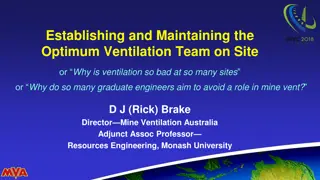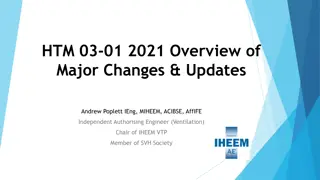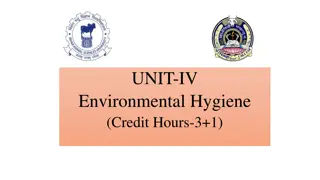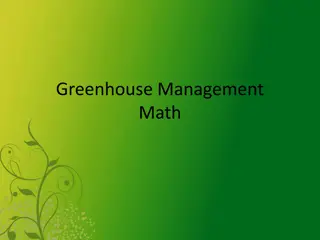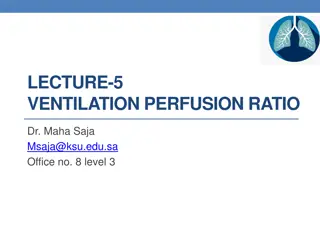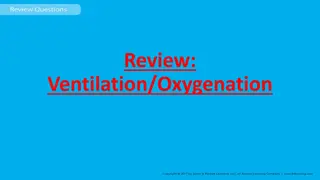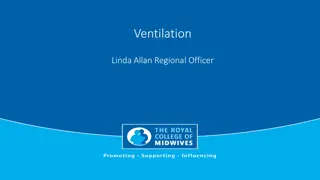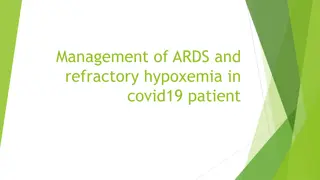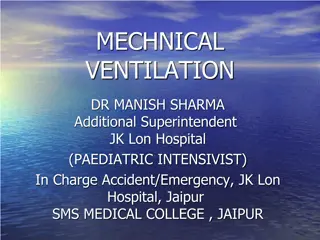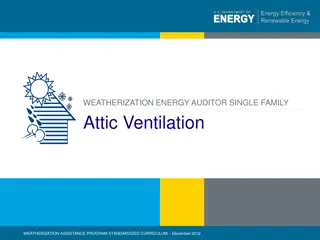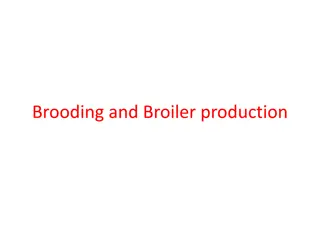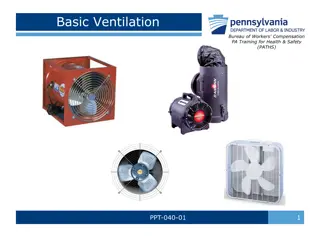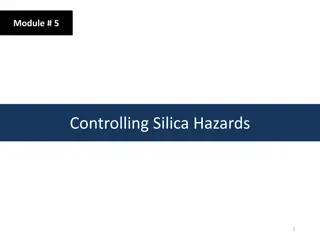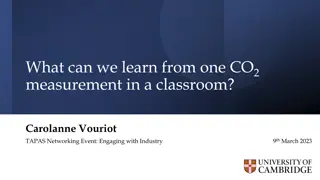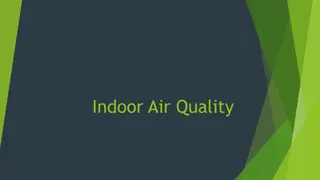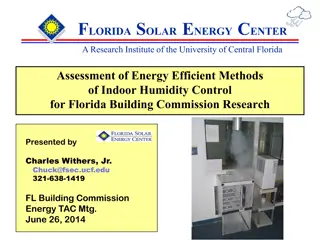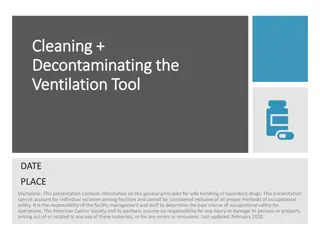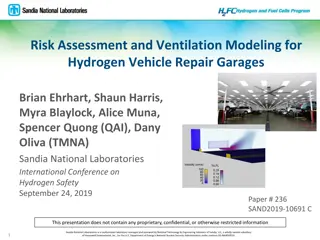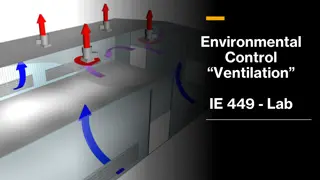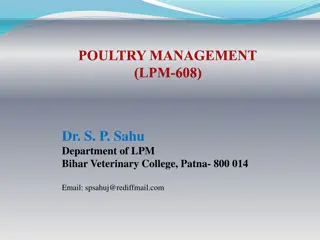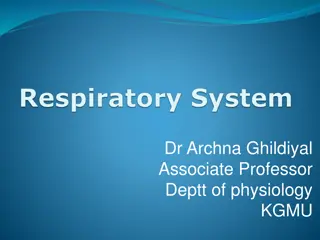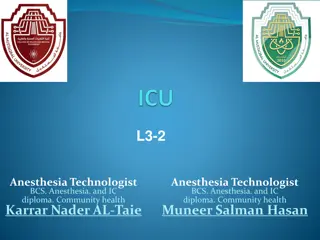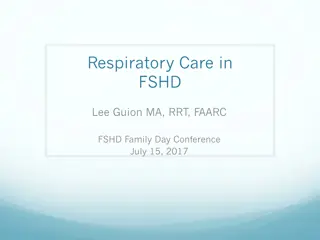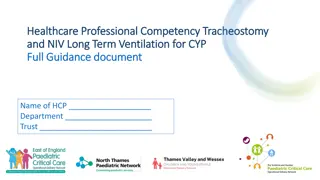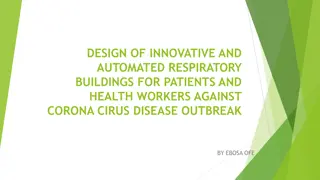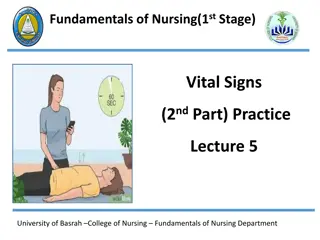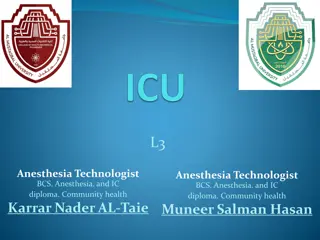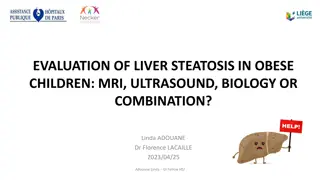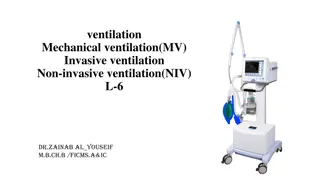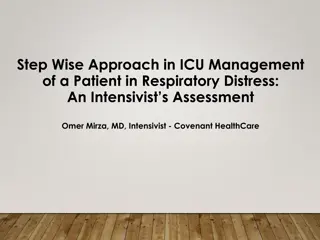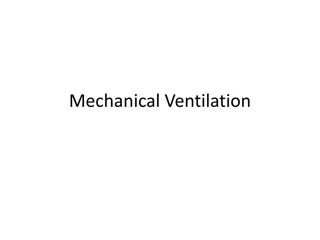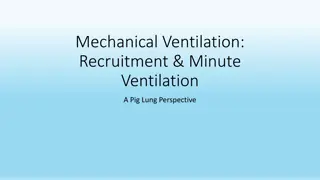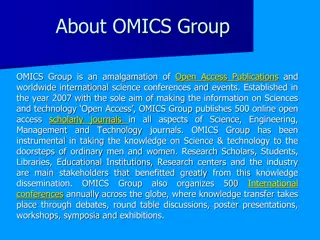Functions of the Respiratory System and Ventilation Mechanism
The respiratory system performs crucial functions such as ventilation to facilitate gas exchange, maintaining pH balance, and enabling vocal sounds. It consists of the upper and lower respiratory systems, including structures like the nose, trachea, bronchi, and alveoli. The system's epithelium, the
7 views • 43 slides
Overview of Mechanical Ventilation in Critical Care
Discussing the indication, modes, variables, and controls of mechanical ventilation as well as the differences between volume and pressure control. Exploring assist control, synchronized intermittent mandatory ventilation, and other key aspects of ventilator management by Dr. Zia Arshad.
0 views • 22 slides
Enhancing Mine Ventilation for Optimal Performance
Discover the key role of ventilation in mining operations, debunking misconceptions about its importance. Learn how good ventilation practices contribute value to a mine, improve safety, reduce costs, and boost productivity. Explore the crucial considerations in establishing and maintaining an effic
0 views • 26 slides
Overview of HTM 03-01-2021 Major Changes & Updates in Healthcare Ventilation Systems
This overview covers the major changes and updates in healthcare ventilation systems as per HTM 03-01-2021. It emphasizes the shift towards net-zero carbon emissions by 2050, promoting sustainable ventilation practices. Key aspects include the role of Ventilation Safety Groups, derogation processes,
0 views • 21 slides
Proper Ventilation for Animal Houses: Importance and Guidelines
Ventilation in animal houses is crucial for removing stale air and replacing it with fresh air to maintain optimal conditions for animals and their attendants. Improper ventilation can lead to various issues like high humidity, disease spread, and vulnerability to pathogens. This article discusses t
0 views • 12 slides
Greenhouse Management and Temperature Control Guide
Learn about the importance of ventilation and temperature control in greenhouse management, including how to calculate required ventilation and heater size. Understand the benefits of proper ventilation, ways to control greenhouse temperature, and essential considerations for heating. Explore step-b
1 views • 21 slides
Comprehensive Overview of Pulmonary Function Tests (PFTs)
Pulmonary Function Tests (PFTs) are vital for assessing pulmonary gas exchange through ventilation, diffusion, and lung perfusion. These tests include measurements of lung volume, airway patency, gas exchange efficacy, and pulmonary blood flow. PFTs offer benefits in diagnosing dyspnea, monitoring d
0 views • 14 slides
Understanding Ventilation-Perfusion Ratio in Pulmonary Circulation
This lecture delves into the intricate relationship between ventilation and perfusion in the lungs, highlighting the importance of proper gas exchange for optimal respiratory function. It discusses the circulations supplying the lungs, defines the V/Q ratio, and explores the clinical significance of
0 views • 25 slides
Understanding Ventilation and Oxygenation in Respiratory Care
Review covers key concepts of ventilation and oxygenation, including the control of breathing, assessment of tidal volume, and the roles of different respiratory centers. Learn about the importance of observing chest rise to assess tidal volume accurately. Gain insights into the brain stem's pivotal
6 views • 41 slides
Importance of Ventilation in the Workplace Environment
Adequate ventilation plays a crucial role in reducing the risk of virus transmission, particularly aerosols, in enclosed areas like workplaces. This presentation highlights the significance of ventilation and how health and safety representatives can collaborate to address concerns. It also discusse
0 views • 20 slides
Effective Management of ARDS and Refractory Hypoxemia in COVID-19 Patients
Management of ARDS involves oxygen support and mechanical ventilation along with treating the underlying cause. Lung-protective ventilation strategies such as the OLA approach are recommended. Refractory hypoxemia in COVID-19 patients is challenging, often requiring adherence to ARDS guidelines. Mai
2 views • 28 slides
Understanding Mechanical Ventilation in Critical Care Environments
Mechanical ventilation, overseen by Dr. Manish Sharma, Pediatric Intensivist at JK Lon Hospital, Jaipur, is essential for treating respiratory failure. It involves using ventilators to deliver gas to the lungs and meet specific goals like correcting hypoxemia and hypercapnia. This process requires u
0 views • 55 slides
Comprehensive Guide to Attic Ventilation for Weatherization Energy Auditors
Explore the purpose, principles, and misconceptions surrounding attic ventilation in single-family homes as part of a weatherization assistance program. Learn about common misconceptions, post-weatherization moisture problems, and passive attic venting techniques using informative visuals provided b
0 views • 23 slides
Brooding and Broiler Production: Essential Factors for Chicken Rearing
Brooding and broiler production play a crucial role in egg production. Incubation of chicks, heat regulation, ventilation, space, disease prevention, and nutrition are key factors controlled by humans for successful chicken rearing. Chicks require proper incubation conditions, including heat sources
0 views • 30 slides
Basic Ventilation Training for Health & Safety
This training presentation covers the basic concepts of ventilation, including reasons for ventilation, proper techniques, student objectives, types of ventilation, methods of ventilation, and ventilation safety precautions. Ventilation is crucial for maintaining high-quality indoor air, removing un
5 views • 22 slides
Controlling Silica Hazards: Effective Engineering Controls
Techniques for controlling silica hazards in the workplace include elimination, substitution, and engineering controls like ventilation, dust containment systems, wet methods, and housekeeping practices. Elimination involves removing silica exposure risks, while substitution replaces risky materials
1 views • 21 slides
Insights from CO2 Measurement in Classroom Ventilation
Understand the significance of CO2 measurements in classroom ventilation for better indoor air quality and reduced infection risks. Explore the use of CO2 sensors, data analysis, and proxy models to improve ventilation systems in schools. Discover findings on airborne infection risk and variations w
2 views • 9 slides
Importance of Indoor Air Quality for Schools and Buildings
Sustainable Jersey for Schools emphasizes the significance of maintaining good Indoor Air Quality (IAQ) in educational facilities. Proper ventilation and sunlight are essential for creating a conducive environment for learning. Neglecting IAQ can lead to health issues and hinder students' and teache
5 views • 48 slides
Energy-Efficient Indoor Humidity Control for Florida Homes with Mechanical Ventilation
Assessment of energy-efficient methods for indoor humidity control in Florida buildings, focusing on code-required mechanical ventilation rates. Research objectives include evaluating approaches and technologies through experiments to manage latent load, improve indoor RH, and reduce energy consumpt
1 views • 20 slides
Safe Handling of Hazardous Drugs - Ventilation Tool Cleaning Procedures
This presentation outlines the proper procedures for cleaning, disinfecting, and organizing ventilation tools, emphasizing the importance of trained operators following written protocols. It covers waste handling, documentation, and the use of personal protective equipment (PPE) for occupational saf
0 views • 24 slides
Risk Assessment and Ventilation Modeling for Hydrogen Vehicle Repair Garages
This paper discusses the demand for additional maintenance facilities in hydrogen vehicle repair garages due to the increased use of hydrogen fuel cell electric vehicles. It highlights the need for ventilation and upgrades in existing facilities to handle hydrogen releases during maintenance. The ob
0 views • 17 slides
Understanding Industrial Ventilation Systems for Workplace Safety
Ventilation plays a crucial role in maintaining a safe working environment by providing fresh air, controlling contaminants, and reducing health risks for workers. This article covers the importance of ventilation, areas at risk of deficiency, components of industrial systems, types of ventilation s
0 views • 18 slides
Effective Poultry Management Practices for Maximum Production Efficiency
Poultry management involves various practices like brooding, ventilation, sanitation, and hygiene to ensure the wellbeing of birds and maximize production efficiency. Implementing scientific methods and personal experience are key to successful poultry management. Specific care needs to be taken dur
0 views • 51 slides
Mechanics of Pulmonary Ventilation and Respiratory Cycle Explained
Understanding the mechanics of pulmonary ventilation is crucial for comprehending the breathing process. This comprehensive overview covers the role of muscles, ribs, pressure changes in alveolar, pleural, and transpulmonary regions, terms related to breathing and ventilation, and the contraction an
0 views • 31 slides
Understanding Mechanical Ventilation in Anesthesia Practice
Anesthesia technologists play a crucial role in managing artificial ventilation, including concepts like Invasive Positive Mechanical Ventilation (IPMV), Fraction of Inspired Oxygen (FIO2), Tidal Volume (VT), Peak Flow Rate, Respiratory Rate, Minute Volume (VE), I:E Ratio, and more. They monitor and
0 views • 27 slides
Respiratory Care in FSHD: Guidelines and Management Overview
Comprehensive overview of respiratory care in Facioscapulohumeral Muscular Dystrophy (FSHD) based on the American Academy of Neurology guidelines. Covers incidence of respiratory insufficiency, assessment of lung function, treatment options including noninvasive ventilation, and strategies for maint
0 views • 16 slides
Healthcare Professional Competency: Tracheostomy and Long-Term Ventilation for Children and Young People
This document provides guidance for healthcare professionals caring for children and young people requiring tracheostomy and long-term ventilation. Developed by experts in pediatric care, the competencies cover essential skills and knowledge necessary for safe and effective patient care outside tert
0 views • 16 slides
Innovative Automated Respiratory Buildings for Corona Virus Outbreak
Ebosa Ofe presents a pioneering design of automated respiratory buildings aimed at safeguarding patients and health workers against the Corona virus outbreak. The buildings utilize advanced ventilation systems to ensure a safe and healthy environment, combating the spread of COVID-19. Explore the co
0 views • 12 slides
Understanding Respiratory Rate and Ventilation in Nursing Practice
This lecture focuses on the vital signs related to respiratory rate, emphasizing the three processes of respiration: ventilation, diffusion, and perfusion. Nurses assess ventilation by observing the rate, depth, and rhythm of respiratory movement, crucial in recognizing normal thoracic and abdominal
0 views • 51 slides
Understanding Mechanical Ventilation in Anesthesia Technology
Mechanical ventilation plays a crucial role in assisting patients with breathing difficulties by delivering oxygen and removing carbon dioxide. It involves two primary types: Negative Pressure Ventilation (NPV) and Positive Pressure Ventilation (PPV). NPV helps patients with conditions like chronic
0 views • 19 slides
Evaluation Methods for Liver Steatosis in Obese Children
This study examines the assessment of liver steatosis in obese children using MRI, ultrasound, and biology techniques, evaluating methods such as attenuation coefficient and proton density fat fraction. The aim is to develop noninvasive biomarkers and validate existing scores for predicting NAFLD. P
0 views • 22 slides
Managing Noninvasive Ventilation Weaning Process
Discontinuing noninvasive ventilation in patients with acute respiratory failure involves a gradual process of assessing the condition, monitoring for distress signs, and adjusting ventilator assistance accordingly. Successful weaning depends on the reversibility of the underlying respiratory issue.
0 views • 28 slides
Ventilation in Critical Care: Basics and Calculations
Understanding mechanical ventilation is crucial in managing critically ill patients. This content covers concepts like I:E ratio, total cycle time calculation, inspiratory and expiratory times, and practical examples. Learn how to adjust ventilator settings based on patient parameters and conditions
0 views • 11 slides
Step-Wise Approach in ICU Management of a Patient in Respiratory Distress
An intensivist outlines a systematic approach for managing an acutely unstable patient in respiratory distress in the ICU. The process includes clinical assessment, noninvasive ventilation options, considerations for vital organ functions, and potential pitfalls to avoid. Emphasis is placed on diffe
0 views • 52 slides
Best Laser Tattoo Removal Services in Silver Sands
If you want the Best Laser Tattoo Removal Services in Silver Sands, visit Pure Aesthetics Clinic. Here at Pure Aesthetics Clinic, they offer a wide range of noninvasive cosmetic treatments including Australia's only plant-based teeth whitening treatm
0 views • 6 slides
Understanding Mechanical Ventilation in COPD Exacerbation
In a case of a 64-year-old woman with COPD exacerbation, managing respiratory distress is crucial. Initiating systemic corticosteroids, doxycycline, and nebulizers while closely monitoring the patient is important. However, in cases where non-invasive ventilation is ineffective, the patient may requ
0 views • 22 slides
Understanding Mechanical Ventilation in a Pig Lung Perspective
Explore recruitment strategies, minute ventilation concepts, and optimization techniques in mechanical ventilation from a unique pig lung perspective. Learn about benefits, recommended PEEP levels, driving pressure, goals of ventilation, and the concept of permissive hypercapnia in respiratory care.
0 views • 14 slides
Overview of OMICS Group and Its International Conferences
OMICS Group, established in 2007, is a prominent entity in the realm of Open Access Publications and global science events. With a focus on disseminating knowledge in various fields, it publishes 500 scholarly journals and hosts numerous conferences worldwide annually. The organization plays a vital
0 views • 18 slides
Temporary Ventilation Project Overview and Challenges
The FE Minute provides an overview of a temporary ventilation project managed by Elisabete Godden, aiming to enhance air flow in classrooms without mechanical ventilation to combat the COVID pandemic. The project involves installing ventilation systems at various spaces within 20 days with a budget
0 views • 14 slides
Design Strategies for Buildings in the UK: A Literature Review
The literature review explores design strategies for buildings in the UK, focusing on ventilation systems, building regulations, and approved document guidelines. Various ventilation systems are discussed, including background ventilators, passive stack ventilation, and mechanical ventilation with h
0 views • 11 slides


